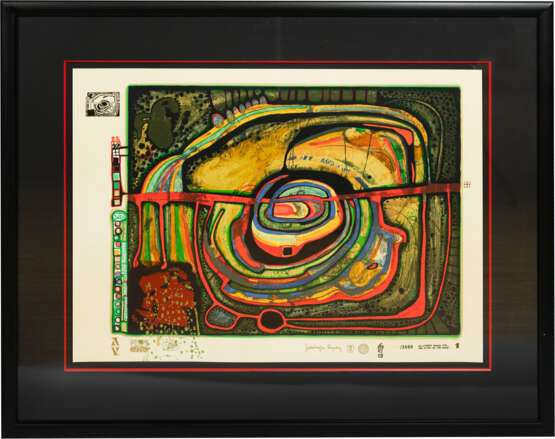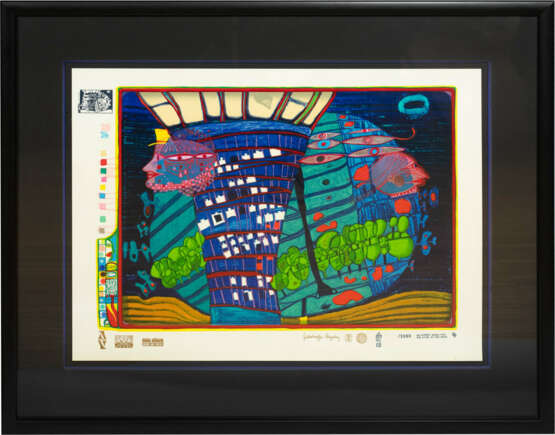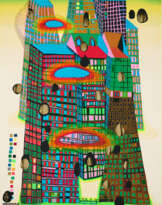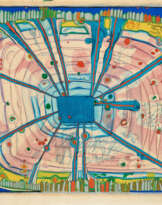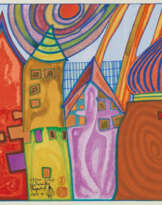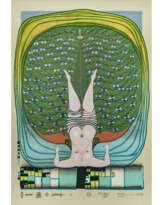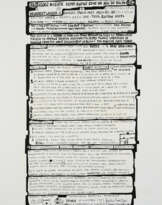ID 952176
Lot 54 | Friedensreich Hundertwasser (1928 Wien - 2000 Brisbane) (F)
Estimate value
€ 7 500 – 10 000
'Look at it on a rainy day', 10-tlg., Regentag-Mappe, in Original-Holzkassette mit farbigem Deckelprägedruck, 10 Farbsiebdrucke mit Metallprägungen auf unterschiedlichen Papieren, 1971/1972, 49 cm x 66,5 cm Blattmaß, je im Druck mit Prägesignaturen, 01560/3000 nummeriert, zum Teil mit Prägestempeln, Kassette handsigniert, 1560 nummeriert, Blatt 10 handsigniert, 156/300 nummeriert, je montiert, Blätter vereinzelt leicht gewellt, minimal knickfaltig, minimal stockfleckig, partiell fleckig, Holzkassette partiell mit kleinen Farb- und Holzabplatzern, Klappscharnier entfernt, Literaur: Wvz. Koschatzky/Kertész 44-53, Fürst HWG 44-53
Friedensreich Hundertwasser ist als Maler, Bildhauer, Architekt und Visionär des 20. Jahrhunderts weltbekannt. Begrünte und bepflanzte Bauwerke, sowie naturnahe Architektur gehörten zu seinem Oeuvre. Ebenso die Malerei mit organischen Formen und entsprechend ausformulierten Grafiken. Damit überzeugte er immer wieder als "Gegner der geraden Linie" und ist für sein Engagement für die Umwelt und seine Heimatstadt Wien bis heute anerkannt. In seiner Auflehnung gegen alles Konservative, was seiner Meinung nach den Krieg ausmachte, wollte er durch die Kraft der Lebendigkeit in seiner Kunst alles Schwere überwinden. Hundertwasser erschuf Utopien aus Fantasie, Form und Farbe, die zusammengesetzt eine Symbiose aus Energie und Kreativität bilden sollte. Immer wieder kehrt er dazu an die Donau zurück, den Fluss durch Wien, als lebendiger Ort, als Wasserlauf, als Ort der Natur in einer Stadt. Die fließenden Formen von Spiralen, symbolträchtigen Kreisläufen des Lebens und schlängelnden Wegen, kreisförmige und gebogene Formen sind dabei sein künstlerisches Vokabular. Mit seiner gestalterischen Kraft wollte er den Bedürfnissen des Menschen entgegenkommen und der Nachkriegsarchitektur und dem Leid der Kriegsjahre durch den Nationalsozialismus und die sogenannte Anhängerschaft Österreichs entgegenwirken. "Warum nicht Bäume aus dem Fenster wachsen lassen? Warum kann die Stadt nicht bewaldet sein?", mit solchen Fragestellungen provozierte er und entwarf Plakate als künstlerisches Ausdrucksmittel und für den Protest, um die damaligen Bewegungen der Ökologie zu fördern. Sein Ziel bestand darin, die Natur und die Menschen zusammen zu bringen. Er arbeitete hin auf eine lebenswerte Zukunft, mit intakter Natur, ihren Elementen und dem Menschen im Einklang dieser Elemente: Feuer, Wasser, Erde und Luft. Der Regen gehört seiner Ansicht nach ebenso dazu, selbst beschreibt er jeden Regentropfen als einen Kuss, wo der Himmel die Erde berührt.
Friedensreich Hundertwasser (1928 Vienna - 2000 Brisbane) (F)
'Look at it on a rainy day', 10 pieces, Rainy day folder, in original wooden case with coloured cover embossing, 10 screen prints in colour with metal embossing on different papers, 1971/1972, 49 cm x 66,5 cm sheet dimension, each printed with embossed signatures, 01560/3000 numbered, partly with embossing stamp, case signed by hand, 1560 numbered, sheet 10 signed by hand, 156/300 numbered, each mounted, sheet 1: Sheet edge minimal thrust, sheet 3: slightly wavy, slightly creased, sheet 4: minimally mildewed, small paper abrasion on the surface, sheet 5: Partially stained, Sheet 7: minimally creased, wooden case partially with small paint and wooden chippings, folding hinge removed, Literaure: Cat. Rais. Koschatzky/Kertész 44-53, Fürst HWG 44-53
Friedensreich Hundertwasser is world famous as a painter, sculptor, architect and visionary of the 20th century. Greened and planted buildings and architecture close to nature were part of his oeuvre. So was painting with organic forms and correspondingly formulated graphics. In this way, he repeatedly convinced as an ''opponent of the straight line'' and is still recognised today for his commitment to the environment and his home city of Vienna. In his rebellion against everything conservative, which in his opinion constituted war, he wanted to overcome everything heavy through the power of liveliness in his art. Hundertwasser created utopias out of fantasy, form and colour, which, when put together, were to form a symbiosis of energy and creativity. Again and again he returned to the Danube, the river running through Vienna, as a living place, as a watercourse, as a place of nature in a city. The flowing forms of spirals, symbolic cycles of life and meandering paths, circular and curved shapes are his artistic vocabulary here. With his creative power, he wanted to meet people's needs and counteract the post-war architecture and the suffering of the war years caused by National Socialism and the so-called followers of Austria. ''Why not let trees grow out of the window? Why can't the city be forested?'', with such questions he provoked and designed posters as a meaning of artistic expression and protest to promote the movements of ecology of the time. His goal was to bring nature and people together. He worked towards a future worth living in, with nature intact, its elements and humans in harmony with these elements: Fire, Water, Earth and Air. In his view, rain is just as much a part of this; he himself describes every raindrop as a kiss where heaven touches the earth.
| Artist: | Friedensreich Hundertwasser (1928 - 2000) |
|---|---|
| Auction house category: | Modern and Contemporary art |
| Artist: | Friedensreich Hundertwasser (1928 - 2000) |
|---|---|
| Auction house category: | Modern and Contemporary art |
| Address of auction |
WETTMANN Luxusuhren Bredeneyer Straße 119-121 45133 Essen Germany | ||||||||||||||
|---|---|---|---|---|---|---|---|---|---|---|---|---|---|---|---|
| Preview |
| ||||||||||||||
| Phone | +4920185785190 | ||||||||||||||
| Fax | +49 (0)208 439 17 35 | ||||||||||||||
| Buyer Premium | 14,28% | ||||||||||||||
| Conditions of purchase | Conditions of purchase | ||||||||||||||
| Shipping |
Postal service Courier service pickup by yourself | ||||||||||||||
| Payment methods |
Wire Transfer | ||||||||||||||
| Business hours | Business hours
|





